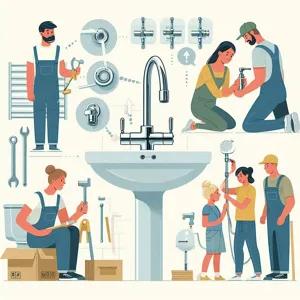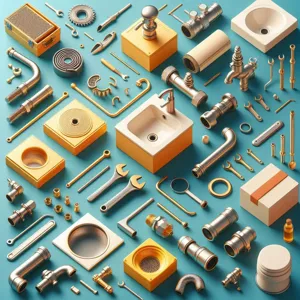When it comes to designing your home, every detail counts, and faucets are no exception.
Often overlooked, the finish of your faucets can dramatically influence the overall aesthetic of your kitchen or bathroom, blending functionality with style. With a plethora of options available—from sleek chrome and warm brass to modern matte black and timeless nickel—the choices can be as overwhelming as they are exciting. Choosing the perfect faucet finish requires a keen understanding of your personal style, existing décor, and the atmosphere you wish to create. In this comprehensive guide, we will explore the various faucet finishes available, delve into their unique characteristics, and provide valuable tips to help you select the ideal finish that not only complements your home but also enhances your daily living experience. Get ready to transform your spaces with the right faucet finish, turning mundane tasks into moments of joy!
1. Introduction to Faucet Finishes
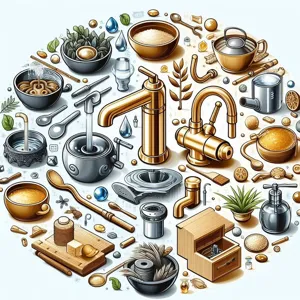
When it comes to designing or renovating your kitchen or bathroom, every detail counts—including the faucet finishes you choose. Faucet finishes not only play a crucial role in the overall aesthetic of your space but also affect the functionality and maintenance of your fixtures. With a myriad of options available, from gleaming chrome to rustic oil-rubbed bronze, selecting the right finish can transform the look and feel of your home.
In this guide, we’ll explore the various types of faucet finishes, discussing their unique characteristics, benefits, and potential drawbacks. Whether you’re aiming for a sleek, modern vibe or a classic, timeless appeal, understanding the nuances of each finish will empower you to make an informed decision.
We’ll delve into popular finishes such as polished nickel, matte black, and brushed stainless steel, examining how they complement different decor styles. Additionally, we’ll touch on practical considerations like durability, ease of cleaning, and resistance to tarnishing, ensuring your faucet not only looks stunning but stands the test of time.
Join us as we embark on this journey through the fascinating world of faucet finishes, helping you find the perfect look that harmonizes with your home’s design and enhances your daily routine.
2. Understanding the Importance of Faucet Finishes
When it comes to home design, the details matter profoundly, and faucet finishes are no exception. The finish of a faucet can dramatically influence the aesthetics of your kitchen or bathroom, acting as a subtle yet striking focal point in your space. Understanding the importance of faucet finishes goes beyond mere appearances; it’s about harmonizing style, functionality, and durability.
Each finish brings its unique character to the table. For instance, chrome faucets offer a sleek, modern look with their bright, reflective surface, making them ideal for contemporary spaces. On the other hand, oil-rubbed bronze delivers a warm, rustic charm, perfect for traditional or farmhouse-style interiors. Matte black finishes have gained popularity in recent years, providing a bold and sophisticated touch that pairs beautifully with a variety of color palettes.
Moreover, the finish you choose can affect the faucet’s maintenance and longevity. Some finishes, like polished nickel, are more resistant to tarnishing and scratches, ensuring your faucet maintains its luster over time. Others, such as brass, develop a unique patina that can enhance their visual appeal but may require more regular upkeep to keep them looking pristine.
In addition to aesthetics and maintenance, consider how the faucet finish will interact with other elements in your space. The right finish can unify your design, linking the faucet with cabinet hardware, light fixtures, and even appliances. By taking the time to understand the importance of faucet finishes, you’re not just making a choice; you’re setting the tone for your entire home. A well-selected finish can elevate your space, making it feel cohesive, stylish, and thoughtfully designed.
3. Popular Faucet Finishes: An Overview
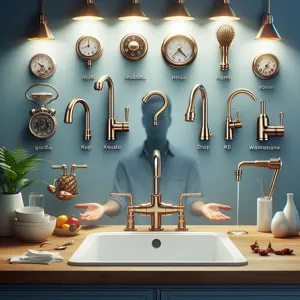
When it comes to selecting the perfect faucet finish for your home, understanding the popular options available is key to making an informed decision. Each finish not only contributes to the aesthetic appeal of your space but also affects the overall ambiance and functionality of your fixtures.
**1. Polished Chrome:** A classic choice, polished chrome faucets exude a sleek, modern vibe that complements a variety of design styles. The reflective surface bounces light around the room, making it an excellent option for smaller spaces. It’s also highly resistant to rust and tarnish, ensuring your faucet maintains its shine with minimal upkeep.
**2. Brushed Nickel:** If you’re looking for a more understated elegance, brushed nickel is an ideal selection. This finish has a soft, muted sheen that hides fingerprints and water spots beautifully, making it a practical choice for busy kitchens and bathrooms. It pairs well with both traditional and contemporary decor, offering versatility in design.
**3. Oil-Rubbed Bronze:** For those who appreciate a rustic or vintage aesthetic, oil-rubbed bronze is a top contender. This rich, dark finish provides a striking contrast against light-colored surfaces and introduces a warm, inviting feel to your space. Its unique patina develops over time, adding character and depth that speaks to its timeless quality.
**4. Matte Black:** The rise of matte black finishes has transformed modern interior design. This bold, sophisticated option adds a touch of drama to any room while maintaining a sleek, minimalist appearance. Matte black faucets work exceptionally well in contemporary and industrial settings, making them a favorite among design enthusiasts.
**5. Polished Gold:** For a luxurious touch, polished gold faucets can elevate your home’s aesthetic to new heights. This eye-catching finish radiates opulence and pairs beautifully with marble countertops and rich colors. However, it’s important to consider the level of maintenance required, as polished gold can be more susceptible to tarnishing.
In summary, the choice of faucet finish can significantly impact both the style and functionality of your space. By exploring these popular options, you can find the perfect look that aligns with your home’s design vision while ensuring durability and ease of maintenance. Whether you opt for the timeless elegance of polished chrome or the luxurious allure of polished gold, the right faucet finish can truly enhance your home’s overall aesthetic.
4. Chrome: The Classic Choice
When it comes to faucet finishes, chrome stands out as the classic choice that has withstood the test of time. Its shiny, reflective surface exudes a sense of cleanliness and modern elegance, making it a staple in both traditional and contemporary kitchens and bathrooms. The allure of chrome lies in its versatility; it seamlessly complements a wide array of décor styles, from minimalist and industrial to farmhouse and classic.
One of the most appealing aspects of chrome finishes is their durability. Crafted from high-quality materials, chrome faucets are resistant to tarnishing and corrosion, ensuring that their radiant luster remains intact even in high-moisture environments. This durability translates to longevity, making chrome a smart investment for homeowners looking for fixtures that will stand the rigors of daily use while maintaining their aesthetic appeal.
In addition to its practical benefits, chrome offers a timeless aesthetic that can enhance any space. The reflective surface captures and plays with light, creating a sense of brightness and openness in your kitchen or bathroom. Whether you opt for a sleek, modern design or a more ornate style, chrome effortlessly adapts, allowing you to create the desired ambiance in your home.
Maintenance is another significant advantage of chrome finishes. With just a soft cloth and mild soap, you can easily wipe away fingerprints and water spots, keeping your fixtures looking pristine. For those who appreciate a low-maintenance option without sacrificing style, chrome is the perfect choice.
In summary, choosing chrome for your faucet finish is not just about aesthetics; it’s a decision rooted in practicality, durability, and timeless elegance. As you explore your options, consider how this classic finish can elevate your home’s overall design, providing a stunning focal point that combines beauty and functionality.
5. Brushed Nickel: A Modern Favorite
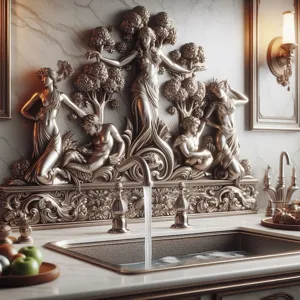
Brushed nickel has emerged as a modern favorite in the realm of faucet finishes, captivating homeowners and designers alike with its sleek appearance and versatile charm. This finish boasts a soft, understated sheen that complements a wide range of design aesthetics, making it a go-to choice for contemporary and transitional spaces.
One of the standout features of brushed nickel is its durability. The brushed texture not only adds a layer of sophistication but also helps to hide fingerprints, water spots, and scratches, keeping your fixtures looking pristine with minimal upkeep. This practical benefit is particularly appealing for busy households where maintenance can often fall by the wayside.
In terms of color, brushed nickel strikes a harmonious balance between warm and cool tones. Its subtle silver hue pairs beautifully with various color palettes, from crisp whites and soft grays to rich jewel tones and earthy shades. This versatility allows it to effortlessly blend in with existing decor or serve as a stunning focal point in a newly designed space.
When considering brushed nickel for your faucets, think about how it can enhance the overall ambiance of your kitchen or bathroom. The finish lends itself well to modern, minimalist designs, but it can also add a touch of elegance to more traditional settings. Whether you opt for a sleek, streamlined design or an ornate, vintage-inspired style, brushed nickel is sure to elevate the aesthetic of your home.
Moreover, this finish is not limited to faucets alone; it can be found on a variety of fixtures and hardware, including cabinet handles, showerheads, and towel bars. This cohesive look can tie together different elements in your space, creating a unified design that feels polished and intentional.
In conclusion, if you’re looking for a faucet finish that embodies modern elegance while offering practical benefits, brushed nickel is an excellent choice. Its timeless appeal and adaptability ensure that it will remain a favorite in home design for years to come, making it a worthy investment for any homeowner looking to enhance their living spaces.
6. Oil-Rubbed Bronze: Timeless Elegance
When it comes to creating a warm and inviting atmosphere in your home, few finishes can compete with the timeless elegance of oil-rubbed bronze. This rich, dark finish exudes a sense of sophistication and history, making it a popular choice for those looking to add a touch of classic style to their spaces.
Oil-rubbed bronze is characterized by its deep brown color, often adorned with subtle highlights that lend an air of vintage charm. The finish is achieved through a special process that not only enhances the visual appeal but also creates a durable surface that resists wear and tear. This makes it an excellent choice for high-traffic areas like kitchens and bathrooms, where faucets are frequently used.
In addition to its aesthetic qualities, oil-rubbed bronze is incredibly versatile. It pairs beautifully with a variety of design styles, from rustic and traditional to modern and industrial. Imagine an oil-rubbed bronze faucet gracefully complementing a farmhouse sink, or elevating the sleek lines of a contemporary countertop. This finish can serve as a stunning focal point in your space, drawing the eye and sparking conversation.
Moreover, the dark hue of oil-rubbed bronze can help conceal water spots and fingerprints, making it a practical choice for busy households. With proper care, it can maintain its beauty for years, aging gracefully and developing a unique patina that adds to its character over time.
If you’re seeking a finish that embodies both style and substance, oil-rubbed bronze is an exceptional option. It not only enhances the visual appeal of your fixtures but also contributes to a cohesive, inviting atmosphere throughout your home. Whether you’re updating a single faucet or undertaking a complete renovation, consider the timeless elegance of oil-rubbed bronze for a look that will stand the test of time.
7. Polished Brass: A Vintage Touch
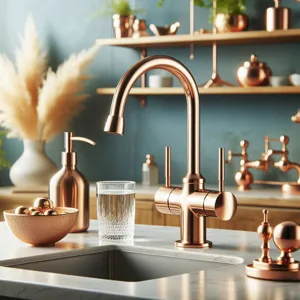
When it comes to infusing your home with a touch of timeless elegance, polished brass faucets stand out as an exceptional choice. This finish exudes a vintage charm that beautifully complements a variety of design aesthetics, from traditional and rustic to modern and eclectic. The gleaming surface of polished brass reflects light in a way that adds warmth and sophistication to any space, making it an eye-catching focal point in your kitchen or bathroom.
The allure of polished brass lies not only in its stunning appearance but also in its rich history. Once a staple in early 20th-century homes, polished brass has made a remarkable comeback, appealing to homeowners who appreciate its classic appeal and character. Its golden hue can evoke a sense of nostalgia, conjuring images of grand estates and elegant Victorian decor.
However, it’s essential to consider the maintenance that comes with this finish. While polished brass undeniably looks luxurious, it does require regular cleaning to maintain its radiant shine. Over time, exposure to moisture and air can lead to tarnishing, which may alter its appearance. But for those who love the vintage aesthetic, this upkeep can be a small price to pay for the beauty and warmth that polished brass brings.
In addition to its visual impact, polished brass is incredibly versatile. It pairs wonderfully with a range of countertops, tile, and cabinetry, allowing you to create a cohesive and inviting atmosphere in your home. Whether used in a classic farmhouse sink or a sleek modern basin, polished brass faucets are sure to be a conversation starter, inviting admiration from guests and family alike.
If you’re looking to add a vintage touch to your home, consider the enduring elegance of polished brass. It’s not just a faucet; it’s a statement piece that embodies a rich heritage while seamlessly blending into contemporary spaces. With its blend of beauty, history, and versatility, polished brass could be the perfect finishing touch your home has been waiting for.
8. Matte Black: The Bold Statement
Matte black faucet finishes have emerged as a bold and stylish choice for modern homes, captivating homeowners with their sleek, contemporary appeal. This striking finish exudes an air of sophistication and elegance, making it an ideal option for those looking to make a statement in their bathroom or kitchen. The beauty of matte black lies not only in its aesthetic charm but also in its versatility; it effortlessly complements a wide range of design styles, from industrial to minimalist, and everything in between.
One of the most alluring aspects of matte black fixtures is their ability to create a striking contrast against lighter elements in your space. Imagine a pristine white sink or a light-colored countertop paired with a matte black faucet—this combination not only draws the eye but also adds depth and dimension to your design. Additionally, matte black finishes are fantastic at hiding fingerprints and water spots, ensuring that your fixtures maintain a clean, polished look even with daily use.
In terms of functionality, matte black faucets are often available in a variety of designs, from sleek and angular to curved and organic, allowing you to find the perfect style to match your personal taste. Moreover, many brands offer matte black options in durable materials that resist tarnishing and corrosion, ensuring that your investment remains stylish and functional for years to come.
When incorporating matte black into your home, consider pairing it with complementary finishes, such as brushed gold or chrome, to create a layered look that exudes luxury and modernity. Whether you’re renovating an entire space or simply updating a few fixtures, choosing matte black can transform an ordinary room into a chic and contemporary retreat, leaving a lasting impression on all who enter.
9. Stainless Steel: Durability Meets Style
When it comes to selecting a faucet finish that marries longevity with aesthetic appeal, stainless steel stands out as a top contender. Renowned for its exceptional durability, stainless steel is not only resistant to rust and corrosion but also boasts a sleek, modern look that complements a variety of design styles. Its neutral tone effortlessly blends with both contemporary and traditional kitchens or bathrooms, making it a versatile choice for homeowners aiming to achieve a cohesive aesthetic.
One of the key advantages of stainless steel finishes is their ability to withstand the rigors of daily use. Unlike other materials that may tarnish or wear over time, stainless steel maintains its polished appearance, even in high-traffic areas. Furthermore, many stainless steel faucets come with a brushed finish, which not only enhances their resilience against scratches and fingerprints but also adds a subtle texture that can elevate your space.
Beyond functionality, stainless steel is lauded for its hygienic properties. The non-porous surface prevents bacterial growth, making it an excellent choice for families who prioritize cleanliness in their home. Additionally, its reflective quality can brighten up a room, creating a sense of openness and sophistication.
When choosing a stainless steel faucet, consider your overall design scheme and the other fixtures in your space. Pairing a stainless steel faucet with complementary materials, such as granite countertops or ceramic sinks, can create a harmonious look that enhances your home’s overall aesthetic. With its blend of practicality and style, a stainless steel faucet is not just an addition to your home—it’s an investment in quality that will stand the test of time.
10. Choosing the Right Finish for Different Spaces
When it comes to choosing the right faucet finish for different spaces in your home, it’s crucial to consider both functionality and aesthetic appeal. Each area has its unique vibe, and the finish you select can enhance the overall design while complementing other elements in the room.
In the kitchen, for example, a polished chrome finish is often favored for its sleek, modern look and exceptional durability. It not only reflects light beautifully, making the space feel more open and airy, but it’s also resistant to tarnishing and easy to clean, which is essential in a high-traffic area where spills and splashes are common. Alternatively, if you’re aiming for a cozy, rustic ambiance, a matte black or oil-rubbed bronze finish can add a touch of warmth and character, perfectly coordinating with wood cabinetry and natural stone countertops.
Moving to the bathroom, the finish you choose can dramatically affect the room’s relaxation and rejuvenation vibe. A brushed nickel finish is a popular choice for its subtle shine and ability to resist fingerprints and water spots, making it ideal for a space that frequently sees moisture. For those looking to create a spa-like retreat, consider a soft champagne or rose gold finish. These hues exude a sense of luxury and elegance, and they pair beautifully with white or light-colored tiles, creating a tranquil atmosphere.
In smaller spaces, such as powder rooms or laundry areas, don’t shy away from experimenting with bold finishes. A polished brass or vibrant matte black faucet can serve as a stunning focal point, drawing the eye and adding personality to otherwise utilitarian spaces.
Ultimately, choosing the right faucet finish for each room is about harmonizing style and practicality. Consider your home’s overall design theme, the specific functions of each space, and how each finish interacts with the light and colors around it. By thoughtfully selecting finishes that reflect both your personal taste and the ambiance of each area, you’ll create a cohesive and inviting atmosphere throughout your home.
11. Coordinating Faucet Finishes with Other Fixtures
When it comes to designing your kitchen or bathroom, coordinating faucet finishes with other fixtures is essential for creating a harmonious and visually appealing space. The faucet is not just a functional element; it is also a key aesthetic feature that can tie the entire room together. To achieve a cohesive look, consider the finishes of your other elements—such as cabinet hardware, light fixtures, and even your appliances.
Start by determining the dominant finish in your space. If you have polished chrome cabinet handles, for instance, a faucet in the same finish will create a seamless look. Alternatively, if you’re leaning towards a more eclectic style, mixing finishes can be a bold statement. Just remember that when mixing, it’s important to find a balance; for example, pairing a matte black faucet with brushed nickel hardware can create a striking contrast without overwhelming the senses.
Moreover, the style of your fixtures should complement each other. A sleek, modern faucet will feel out of place with ornate, vintage cabinet pulls. Instead, opt for a consistent design language that reflects your overall aesthetic, whether it’s contemporary, traditional, or somewhere in between.
Don’t forget to consider the color palette of your room as well. If your space features warm tones, a brass or gold faucet can add an inviting touch, while cooler tones may pair better with polished chrome or stainless steel.
Finally, think about the durability and maintenance of the finishes you choose. Some finishes, like oil-rubbed bronze, may require more upkeep to maintain their appearance compared to others, such as chrome or stainless steel, which are often more resistant to tarnishing.
By thoughtfully coordinating your faucet finish with other fixtures, you not only enhance the beauty of your space but also create a functional environment that reflects your personal style.
12. Maintenance Tips for Different Faucet Finishes
When it comes to choosing the perfect faucet finish for your home, it’s essential to consider not only the aesthetic appeal but also the maintenance required to keep your fixtures looking pristine. Different finishes have unique properties and upkeep needs, and understanding these can help you make an informed decision that will complement your lifestyle.
**Polished Chrome**: One of the most popular choices, polished chrome faucets are known for their bright, shiny appearance. However, they can show water spots and fingerprints easily. To maintain their luster, regularly wipe them down with a soft, damp cloth after use, and occasionally polish them with a gentle, non-abrasive cleaner designed for chrome.
**Brushed Nickel**: If you prefer a more muted, sophisticated look, brushed nickel is an excellent option. Its textured surface helps hide water spots and fingerprints, making it relatively low-maintenance. Simply clean it with warm soapy water and a soft cloth to avoid scratching. For tougher stains, a mixture of vinegar and baking soda can work wonders, but be sure to rinse thoroughly afterward.
**Oil-Rubbed Bronze**: This finish adds a rich, vintage flair to any space but requires a bit more care to maintain its dark hue. It can develop a patina over time, which many homeowners appreciate for its character. To clean, use a mild soap solution and a soft cloth, avoiding harsh chemicals that can strip away the finish. For deeper cleaning, an occasional application of mineral oil can help rejuvenate its appearance.
**Matte Black**: As a bold and trendy choice, matte black faucets are striking but can show dust and water spots more readily. To keep them looking sharp, use a microfiber cloth to wipe away grime and fingerprints regularly. Avoid abrasive cleaners that could scratch the surface; instead, opt for a gentle soap solution when a deeper clean is necessary.
**Stainless Steel**: Renowned for its durability and modern look, stainless steel is resistant to corrosion and tarnishing. To maintain its polished appearance, wipe with a soft cloth and mild detergent. For stubborn stains, a stainless steel cleaner can restore its shine. However, be cautious with abrasive pads, as they can scratch the surface.
By understanding the maintenance requirements for each faucet finish, you can choose one that not only enhances your home’s aesthetic but also fits seamlessly into your cleaning routine. With the right care, your faucets will not only serve their practical purpose but also remain a stunning focal point in your kitchen or bathroom for years to come.
13. Trends in Faucet Finishes for 2024
As we step into 2024, the world of faucet finishes is evolving, offering a stunning array of options that reflect the latest design trends and homeowner preferences. This year, we’re witnessing a remarkable fusion of classic aesthetics with modern flair, making it easier than ever to find the perfect finish that complements your home’s style.
One of the standout trends for 2024 is the resurgence of matte black finishes. This bold choice is favored for its sleek, contemporary look and its ability to provide a striking contrast against lighter countertops and cabinetry. Matte black faucets not only add a touch of sophistication, but they also hide fingerprints and water spots, making them a practical option for busy kitchens and bathrooms.
In contrast, the warmth of brass and gold tones continues to gain popularity, offering a timeless elegance that can elevate any space. These finishes are being reimagined with brushed and polished textures, allowing for versatility from vintage-inspired to modern chic. The soft, inviting glow of these metallics brings a luxurious feel to your home, making them a perfect choice for those looking to make a statement.
Another exciting trend is the use of mixed finishes. This approach allows homeowners to combine various faucet finishes in a single space, creating a unique and personalized look. For instance, pairing a matte black faucet with brushed nickel or polished brass accessories can yield a dynamic visual interest that tells a story of eclectic style.
Lastly, eco-conscious finishes are making waves in 2024, with many manufacturers focusing on sustainable materials and finishes that are both beautiful and environmentally friendly. These options not only look great but also align with the growing trend of creating greener homes.
As you explore your options, consider these trends in faucet finishes for 2024. Whether you lean towards bold contrasts, timeless metallics, a mix-and-match approach, or eco-friendly choices, there’s a finish out there that will perfectly enhance your home’s aesthetic and reflect your personal style.
14. How to Test Faucet Finishes for Quality
When it comes to choosing the perfect faucet finish for your home, quality should be at the forefront of your decision-making process. A beautiful faucet can elevate your space, but if it wears down or tarnishes quickly, it can become a source of frustration rather than a feature of pride. Here’s how to assess faucet finishes to ensure you’re making a wise investment.
Start by examining the finish closely. High-quality faucets often have a uniform appearance, with an even coating that lacks imperfections such as bubbles, scratches, or discoloration. Pay special attention to the edges and corners, as these are areas where subpar finishes might show wear more quickly.
Next, perform the ‘scratch test.’ While it might sound a bit unorthodox, gently scratching the surface with a fingernail or a soft cloth can provide insights into the durability of the finish. If you see noticeable marks or if the finish seems to wear away easily, you’re likely dealing with a lower-quality product. Conversely, a premium finish should resist scratching and maintain its luster even under light pressure.
Water resistance is another critical factor. A simple water test can demonstrate how well the finish holds up against moisture. Spray a small amount of water on the faucet and let it sit for a few minutes before wiping it away. A high-quality finish will repel water efficiently, allowing it to bead up rather than create water spots or stains.
Lastly, check for warranty information. Reputable manufacturers often provide warranties that cover material and finish defects for a specified period. A solid warranty not only reflects confidence in the product’s quality but also offers you peace of mind in your investment.
By taking these steps to test faucet finishes for quality, you can ensure that your selection not only complements your aesthetic but stands the test of time in both function and style. After all, a faucet should be more than just a pretty face—it’s a daily use item that deserves to be both beautiful and durable.
15. Conclusion: Finding Your Perfect Faucet Finish
In conclusion, selecting the perfect faucet finish for your home is a journey that balances aesthetics, functionality, and personal style. Each finish—whether it be the timeless elegance of polished chrome, the warm sophistication of brushed nickel, or the bold statement of matte black—offers its own unique charm and character. As you explore the myriad of options available, consider the overall design of your space, the existing fixtures, and how the faucet will integrate into your daily life.
Take the time to envision how different finishes will interact with your kitchen or bathroom decor. Imagine the way sunlight will dance off a shiny polished brass faucet versus the subtle glow of a satin bronze fixture. Reflect on maintenance requirements, as some finishes may demand more attention than others to keep them looking pristine.
Ultimately, the perfect faucet finish is one that resonates with your personal taste while enhancing your home’s functionality. With thoughtful consideration and a bit of creativity, you can choose a finish that not only elevates your space but also brings joy to your everyday routines. Remember, this seemingly small detail can have a significant impact on the ambiance of your home, so choose wisely and enjoy the process of making your space uniquely yours.
In conclusion, selecting the right faucet finish for your home is not just about aesthetics; it’s about creating a cohesive look that reflects your personal style and enhances the overall ambiance of your spaces. As we’ve explored in this guide, each finish—from polished chrome to brushed nickel, matte black, and beyond—offers its own unique charm and practical benefits. By considering factors such as durability, maintenance, and how each finish complements your existing décor, you can make an informed decision that elevates your kitchen or bathroom. We hope this guide has inspired you to confidently navigate the world of faucet finishes and transform your home into a beautiful and functional sanctuary. Happy decorating, and may your choice of finishes bring you joy for years to come!



